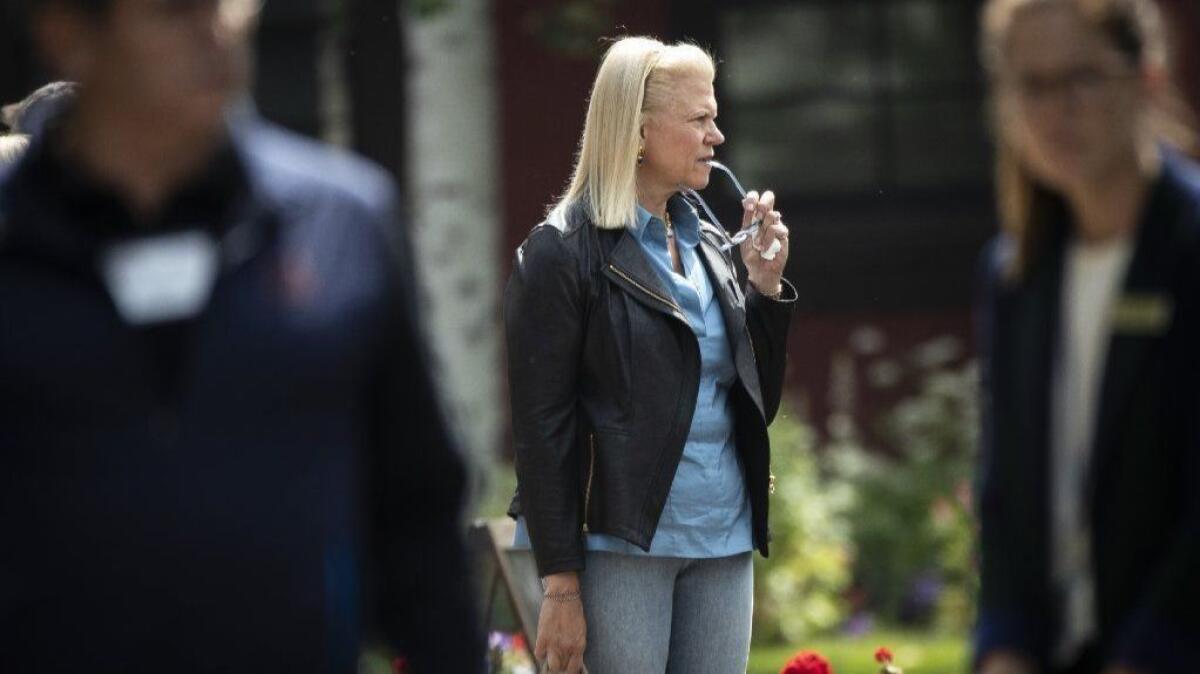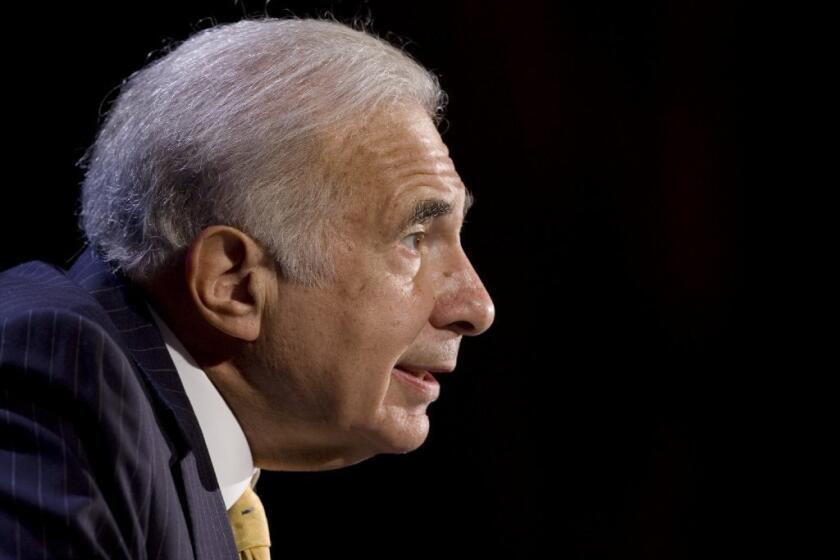Ginni Rometty’s lousy record — but excellent pay — at IBM

- Share via
Let us pause to say orisons over the career of Virginia Rometty as CEO of the computing behemoth IBM.
Rometty, whose retirement from that post after eight years at IBM’s helm was announced Thursday, presided over a decline in the company’s share price of roughly 26%. That’s unadjusted for dividends.
Throw those in, and the best one could say as an investor is that IBM has been dead money: The shares closed on Jan. 1, 2012, the day she took over, at $138.54 and closed on Thursday at $136.77.
On Friday, when the broad market gave up 1.77% largely on coronavirus fears, IBM gained more than 5%, closing at $143.70. It’s reasonable to take the gain as a signal that investors are hoping for better results under new management.
Rometty’s reign included one stretch of 22 straight quarters of declining revenue. That run finally ended in the fourth quarter of 2017, but the company’s annual results continued to be dismal. Year-to-year revenue growth was negative in 2015, 2016 and 2017 but eked out a 1% gain in 2018.
There were bright spots, however, albeit mostly for Rometty. She collected about $137 million in compensation over the first seven years of her CEO-ship (her pay for 2019 hasn’t yet been disclosed).
For a time, I posted annual comparisons of Rometty’s pay to IBM’s performance under her leadership. Since she’s now leaving, it’s proper to take final stock. Rometty will remain IBM’s executive chairman through the end of the year, but IBM named Arvind Krishna, who comes from the technical and research side, her successor as chief executive. Rometty came from sales.
The short version of the story is that Rometty was treated indulgently by the board of directors, when IBM’s performance was mediocre or just plain bad, and spectacularly well when its performance was rather OK.
Overall, the company was in troubled condition for most of Rometty’s tenure. One reason was that it was unable to keep up with competition in cloud services, the flavor of the decade in the information services field.
Put simply, IBM’s traditional large-enterprise customer base was moving from in-house services managed by IBM to outsourced services in the cloud — and IBM was being outcompeted by rivals such as Amazon Web Services and offerings from Microsoft and Alphabet (parent of Google).
IBM Chairman and Chief Executive Virginia Rometty had a pretty good 2016.
To be fair, it’s not unusual for a company in the technology sector to fall by the wayside, even after decades of domination. The same fate has befallen Xerox, Hewlett-Packard and General Electric, after all.
Rometty worked hard to shore up IBM’s position in the evolving field, but success seemed perennially to lurk just over the horizon. As it happens, her most eye-catching move in this vein was the $34-billion acquisition of Red Hat, a leading firm in what’s known as hybrid cloud environments, which closed last summer. Krishna is reported to have been the main architect of that deal, and Red Hat’s CEO, James Whitehurst, will take over Rometty’s title of IBM president.
Meanwhile, however, Rometty became an exemplar of the dysfunction in executive compensation in U.S. industry. Rometty was probably not the most overpaid chief executive in America, but given IBM’s size and stature, it’s not unfair to take a closer look at her compensation.
In 2015, for a start, IBM announced (quietly) that it had granted Rometty a $3.6-million bonus for 2014 and a $13.3-million stock incentive award payable in 2018. She also received a 6.7% bump in her base salary, to $1.6 million from $1.5 million.
That was based on a record for 2014 that included a nearly 6% decline in revenue and a plunge in net income of 27%. IBM shares began 2014 at a dividend-adjusted $183.12 and ended the year at $160.44, a drop of 12.4%. During that period, the Standard & Poor’s 500 index rose 12.4%. IBM had been the worst-performing stock on the Dow Jones industrial average for two years in a row.
The board tried to suggest that Rometty was being docked for what it called “the shortfall in financial results relative to expectations” — her compensation came to only 74% of the targeted maximum, after all — but it said it balanced the shortfall “against the substantial strategic actions taken to reposition the company, including the expansion into new markets with competitive offerings and execution of significant restructuring and divestitures.” In other words, little harm, little foul.
The following year, Rometty notched IBM’s 15th straight quarter of declining revenue, profit was down 15% and the stock had fallen 36% from its peak. She received a $4.5-million bonus, up from the previous year’s $3.6 million, plus stock options and restricted shares. Her total compensation was $18.6 million, down about $700,000 from the year before.
In 2016, Rometty had a pretty good year, with the share price gaining 20.6%, its best performance since the year before she took over. The board gave her a bonus of $4.95 million, her biggest ever until the following year, when it rose to $5.1 million (though the stock had fallen by nearly 7.6%).
As I mentioned in 2016, there has never been any mystery why Rometty’s pay, like that of other CEOs of major corporations, remains buoyant in good times and bad: It’s cultural. In 2019, eight of the 11 board members (not counting Rometty herself) were themselves current or former CEOs of major corporations, as were three of the four members of the board’s compensation committee.
A merger of Xerox and HP would say more about the past of the computer industry than the companies’ future.
In other words, they were distinguished representatives of America’s CEO culture, which turns a blind eye to performance that warrants a pay cut, not to mention a firing. When performance stalls or declines, they often find a silver lining, citing “progress” toward a distant goal.
In 2015, for instance, IBM’s then-chief financial officer, Martin Schroeter, said during an investor conference call that the company’s “strategic” transition toward “big data and analytics, around cloud, and around mobile and security” was still underway. It was just that signs of its progress “toward these strategic imperatives, and in the investments we’ve been making ... aren’t yet reflected in our revenue streams,” he said.
It’s possible that Rometty’s efforts to move IBM into the 21st century technological world will finally bear fruit; management is optimistic about the Red Hat deal, as was made clear by Whitehurst’s elevation (and the rich price of the acquisition). If that happens, Rometty will be well-placed to take credit for finally turning IBM around. But she already has been paid for the achievement, in spades. If it fails, the IBM board can mark it down as just another failed investment, and count Rometty’s pay as part of the cost.
More to Read
Inside the business of entertainment
The Wide Shot brings you news, analysis and insights on everything from streaming wars to production — and what it all means for the future.
You may occasionally receive promotional content from the Los Angeles Times.













